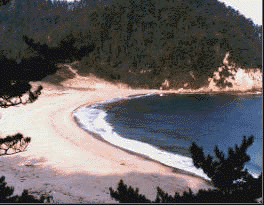
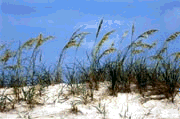
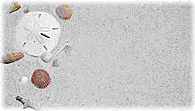
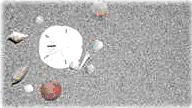
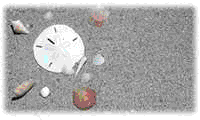

Bonnie Glasgold, P.S. 101
AIM: What is sand?
MOTIVATION: Ask students where do they think we find sand? What do they think sand is made of? Have children go to various locations on the Internet to see the different types of sand. The following sites are good for this task:
http://ed.uri.edu/homepage/projects/ocean/Sand4.htm
http://awesomeflorida.com/beaches/beach_sand.htm
Pictures 1, 2, and 6 are from the first site, and pictures 3,4, and 5 are from Awesome Florida.
|
|
 |
 |
|
|
|

|
MATERIALS: Computers with Internet access, printer, word processing program such as Microsoft Word or Apple Works, books on beaches, sand, and samples of different types of sand (fine, rough, gravelly, rocky, etc.), hand lens, and a .variety of shells
PROCEDURE:
1. Discuss the Internet pictures and ask the following questions:
a. Do the sands all look the same? (Since sand is made from rock, different sands have different appearances: color, size, texture, etc, depending on the originating material).
b. Are all the sands found in the same kinds of places? Where are some of the different places we can find sand? (beaches, deserts)
c. What does it look like the sand was made from?
d. What forces do you think help make sand? Discuss erosion, wind, waves, rushing water.
2. Introduce vocabulary for this lesson: sand, grain, erosion, texture, beach, dune, rock, shell
3. Have children observe the different samples of sand. They can look through the hand lens to see the different size, grain, and texture of each sample. Have them compare the differences of each sample.
4. Do the activities listed below.
ACTIVITIES:
1. ( This activity is written in Scientific Method)
Problem: How can we make sand?
Hypothesis: We think if we can duplicate some kind of erosion, then we can make sand.
Materials: sugar cubes, small glass jar, children
Procedure: 1. Place two sugar cubes in the jar to represent rocks. 2. Close the jar and have each student take a turn shaking the jar as hard as they can. (This will compare to natural forces of erosion). 3. Observe the residue in the jar with a hand lens.
Observations: Children should be able to see that the sugar cubes have eroded and the edges of the cubes are now rounded, and there should be many crystals of sugar at the bottom of the jar. They can make a T chart to compare the sugar cube before and after.
| Sugar- Before | Sugar- After |
| white | white |
| rectangular solid | smaller, oval |
| small pieces, like sand residue on the bottom of the jar |
Conclusion: Children should be able to state what they have learned about how sand is formed from the experiment.
2. Have children log on to http://ed.uri.edu/homepage/projects/ocean/Sand4.htm and answer the following questions:
a. What are some of the common minerals found in Rhode Island sand?
b. What is musical sand? ( Musical sand on a beach or desert is a silica sand which makes a peculiar sound when moving).
c. Where are some places in the world where musical sand can be found?
FOLLOW-UP:
This lesson will lead into the next one "What
are characteristics of the shore?"